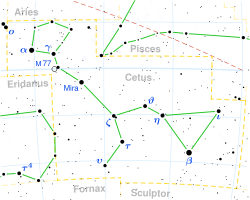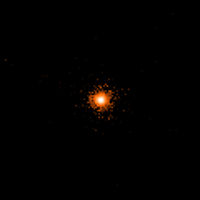- Beta Ceti
-
Deneb Kaitos, β Cet Observation data
Epoch J2000 Equinox J2000Constellation Cetus Right ascension 00h 43m 35.37s [1] Declination -17° 59′ 11.8″ [1] Apparent magnitude (V) 2.04 [2] Characteristics Spectral type K0 III [2] U−B color index 0.87 [3] B−V color index 1.02[3] Variable type Rotationally Astrometry Radial velocity (Rv) +12.8 km/s Proper motion (μ) RA: 232.55 ± 0.18 [1] mas/yr
Dec.: 31.99 ± 0.12 [1] mas/yrParallax (π) 33.86 ± 0.16[1] mas Distance 96.3 ± 0.5 ly
(29.5 ± 0.1 pc)Absolute magnitude (MV) −0.31 Details Mass 3 [4] M☉ Radius 17 [4] R☉ Luminosity 145 [4] L☉ Temperature 4,800 [4] K Metallicity -0.09 Fe/H [5] Rotational velocity (v sin i) 18[6] km/s Age 108 years Other designations Database references SIMBAD data ARICNS data Beta Ceti (β Cet, β Ceti) is the brightest star in the constellation Cetus. Although it has the Bayer designation "beta", it is actually brighter than Alpha Ceti. It has the traditional names Deneb Kaitos and Diphda. This orange giant is easy to identify due to its location in an otherwise dark section of the celestial sphere.
Contents
Properties
Deneb Kaitos has a stellar classification on the border between G and K, making it a yellowish star somewhat cooler than the Sun. In spite of its cooler temperature, Deneb Kaitos is much brighter than the Sun with a bolometric luminosity of about 145 L☉ resulting from a mass that is 3M☉ and a radius of about 17R☉. Deneb Kaitos appears to be an older star having left the main sequence on its way to its red giant evolutionary phase. With an apparent magnitude of 2.04 it ranks among the brighter stars in the night sky, having an absolute magnitude of −0.31. At only 96 light years from the Earth,[1] Deneb Kaitos is one of the nearer stars of a bright apparent magnitude. It can be located at declination −17° 59' 11.8" and right ascension of 00:43:35.37 (2000).[1]
Etymology
The traditional name Deneb Kaitos is Arabic ألضنب ألقيتوس ألجنوب - Al Dhanab al Ḳaiṭos al Janūbīyy for "southern tail of Cetus"; it is also known as Diphda, "frog", from the Arabic الضفدع الثاني aḍ-ḍafdaʿ aṯ-ṯānī "the second frog" ("the first frog" is Fomalhaut).[7]
In Chinese astronomy, Deneb Kaitos is called 土司空, Pinyin: Tǔsīkōng, meaning Master of Constructions, because this star is marking itself and stand alone in Master of Constructions asterism, Legs mansion (see : Chinese constellation)[8]. 土司空 (Tǔsīkōng), westernized into Too Sze Kung by R.H. Allen and the meaning is "Superintendent of Earthworks." [9]
Diphda as the name
USS Diphda (AKA-59) is once of United States navy ship.
See also
- Lists of stars in the constellation Cetus
- Class K Stars
- Giant star
References
- ^ a b c d e f g van Leeuwen, F. (2007). "HIP 3419". Hipparcos, the New Reduction. http://webviz.u-strasbg.fr/viz-bin/VizieR-5?-out.add=.&-source=I/311/hip2&recno=3412. Retrieved 2010-08-22.
- ^ a b "SIMBAD query result: * bet Cet -- Variable Star". Centre de Données astronomiques de Strasbourg. http://simbad.u-strasbg.fr/simbad/sim-id?Ident=Beta+Ceti. Retrieved 2010-09-30.
- ^ a b Mermilliod, J.-C. (1986). "Compilation of Eggen's UBV data, transformed to UBV (unpublished)". Catalogue of Eggen's UBV data. Bibcode 1986EgUBV........0M.
- ^ a b c d Professor James B. (Jim) Kaler. "DENEB KAITOS (Beta Ceti)". University of Illinois. http://stars.astro.illinois.edu/sow/denebkaitos.html. Retrieved 2010-09-30.
- ^ McWilliam, Andrew (December 1990). "High-resolution spectroscopic survey of 671 GK giants" (PDF). Astrophysical Journal Supplement Series (ISSN 0067-0049), vol. 74: p. 1075–1128. Bibcode 1990ApJS...74.1075M. doi:10.1086/191527.
- ^ "Bright Star Catalogue, 5th Revised Ed. (Hoffleit+, 1991)". VizieR. Centre de Données astronomiques de Strasbourg. http://vizier.u-strasbg.fr/viz-bin/VizieR-S?HR%206695. Retrieved 2010-09-30.
- ^ Allen, R. H. (1963). Star Names: Their Lore and Meaning (Reprint ed.). New York: Dover Publications Inc. p. 163. ISBN 0486210790. http://penelope.uchicago.edu/Thayer/E/Gazetteer/Topics/astronomy/_Texts/secondary/ALLSTA/Cetus*.html. Retrieved 2010-12-12.
- ^ (Chinese) AEEA (Activities of Exhibition and Education in Astronomy) 天文教育資訊網 2006 年 7 月 9 日
- ^ Star Name - R.H. Allen p. 160
External links
- Jim Kaler's Stars, University of Illinois: DENEB KAITOS (Beta Ceti)
- Beta Ceti: Giant Star's Corona Brightens with Age
Bayer α (Menkar) • β (Deneb Kaitos, Diphda) • γ (Kaffaljidhma) • δ • ε • ζ (Baten Kaitos) • η • θ • ι • κ1 • λ • μ • ν • ο A (Mira) • ο B (VZ Ceti) • π • ρ • σ • τ • χFlamsteed 1 • 2 • 3 • 6 • 7 • 8 (ι) • 9 • 10 • 11 • 12 • 13 • 14 • 15 • 16 (β, Deneb Kaitos, Diphda) • 18 • 20 • 21 • 25 • 26 • 27 • 28 • 29 • 30 • 31 (η) • 32 • 33 • 34 • 35 • 36 • 37 • 38 • 39 • 40 • 41 • 42 • 43 • 44 • 45 (θ) • 46 • 47 • 48 • 49 • 50 • 52 (τ) • 53 (χ) • 55 (ζ, Baten Kaitos) • 57 • 58 • 61 • 62 • 63 • 64 • 66 • 67 • 68 A(ο A, Mira) • 68 B(ο B, VZ Ceti) • 69 • 70 • 71 • 72 (ρ) • 75 • 76 (σ) • 77 • 78 (ν) • 79 • 80 • 81 • 82 (δ) • 83 (ε) • 84 • 86 (γ, Kaffaljidhma) • 87 (μ) • 89 (π) • 91 (λ) • 92 (α, Menkar) • 93 • 94 • 95 • 96 (κ1) • 25 AriNearby WISE 0254+0223Categories:- Giant star stubs
- Bayer objects
- Cetus constellation
- K-type giants
- Stars with proper names
Wikimedia Foundation. 2010.


